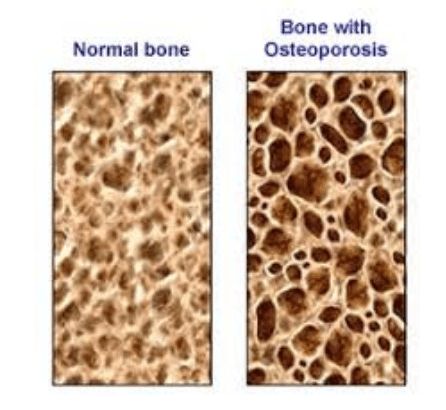
What Is The Disease Osteoporosis?
What Is The Disease Osteoporosis?
What Is The Disease Osteoporosis?
Osteoporosis is a bone disease that occurs when the body loses too much bone, makes too little bone, or both.
Osteoporosis means; “Porous Bone”.
Osteoporosis Disease is a condition characterized by a decrease in the density of bone, decreasing its strength and resulting in fragile bones.
Osteoporosis Disease leads to abnormally porous bone that is compressible, like a sponge.
The Osteoporosis disorder of the skeleton weakens the bone and results in frequent fractures (breaks) in the bones.
A person with Osteoporosis may easily break a bone from a fall.
If a person has a sufficient case of Osteoporosis Disease they may break a bone from sneezing or a minor bump.
What Causes Osteoporosis Disease?
Women with small body frames have a higher chance of developing Osteoporosis Disease.
Here are some additional risk factor of developing Osteoporosis Disease;
- Hyperthyroid Disease a condition wherein too much thyroid hormone is produced by the thyroid gland (as in Grave’s disease)
- Hyperparathyroidism is a disease wherein there is excessive parathyroid hormone production by the parathyroid gland
- Chronic inflammation, due to chronic inflammatory arthritis or diseases, such as rheumatoid arthritis or liver diseases
- Vitamin D deficiency
- Disorders of connective tissue, including osteogenesis imperfecta, homocystinuria, osteoporosis-pseudo glioma syndrome and skin diseases, such as Marfan syndrome and Ehlers-Danlos syndrome (These causes of hereditary secondary osteoporosis each are treated differently.)
- Certain medications can cause osteoporosis. These medicines include long-term use of heparin (a blood thinner), antiseizure medicine such as phenytoin (Dilantin) and phenobarbital, and long-term use of oral corticosteroids (such as prednisone)
Osteoporosis can be present without any symptoms for decades because osteoporosis does not cause symptoms until bone breaks (fractures).
In additional, some osteoporotic fractures may escape detection for years when they do not cause symptoms.
Some patients with Osteoporosis Disease may not be aware of their osteoporosis until they suffer a painful fracture.
On a personal note, I have Dexa bone scans every three years because of my prolonged use of corticosteroids.
Who Should Have A Dexa Bone Scan;
The National Osteoporosis Foundation guidelines state that there are several groups of people who should consider DXA testing for the proper diagnosis of bone health:
- All postmenopausal women below age 65 who have risk factors for osteoporosis
- All women aged 65 and older Postmenopausal women with fractures
- Women with any of more than 50 medical conditions associated with osteoporosis
How To Prevent Osteoporosis Disease;
The following calcium intake has been recommended by the National Institutes of Health Consensus Conference on Osteoporosis for all people, with or without osteoporosis:
- 800 mg/day for children 1-10 years of age
- 1,000 mg/day for men, premenopausal women, and postmenopausal women also taking estrogen
- 1,200 mg/day for teenagers and young adults 11-24 years of age
- 1,500 mg/day for postmenopausal women not taking estrogen
- 1,200 mg-1,500 mg/day for pregnant and nursing mothers
The total daily intake of calcium should not exceed 2,000 mg.
Health Resources:
http://www.mayoclinic.org/diseases-conditions/osteoporosis/symptoms-causes/dxc-20207860
http://www.medicinenet.com/osteoporosis/article.htm
Play It Forward So Others Do Not Have To Rewind
Please, Like HypoGal on Facebook.
